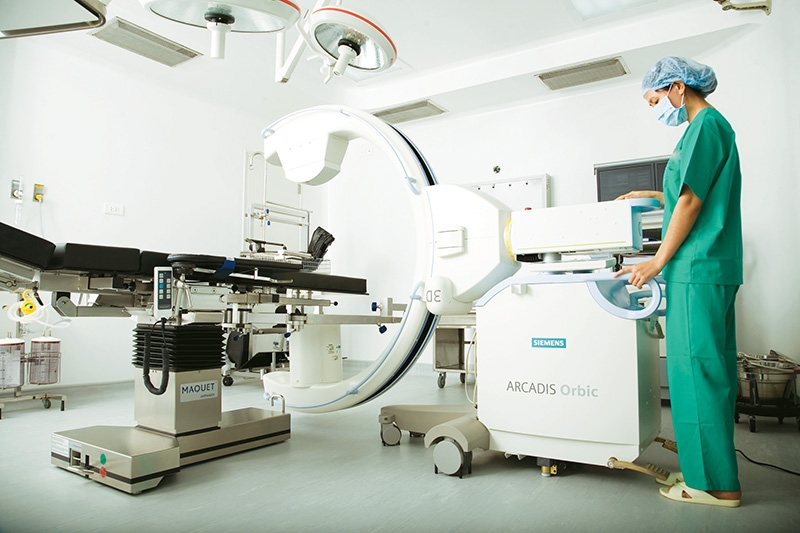Wait goes on for medical VAT clarity
 |
| Around 90 per cent of Vietnam’s diagnostic and medical devices are made up of imports, photo Le Toan |
The European Chamber of Commerce in Vietnam (EuroCham) at the Vietnam Business Forum held last December once again called on the Ministry of Finance (MoF) to provide a detailed timeline for amending the circulars guiding the VAT charge on medical device imports, with members shouldering a 10 per cent rate for a long time now.
A representative of EuroCham said, “The MoF is drafting the amendments to Circular No.83/2014/TT-BTC and guiding documents. However, Circular No.26/2015/TT-BTC is also a major challenge that requires attention. This issue has long been affecting the importation of medical devices.”
Circular 26 dated 2015 provides guidance on VAT, while Circular 83 guides the application of VAT according to Vietnam’s list of imports.
“We recommend the MoF to issue a guiding document on applying VAT on imported medical devices as soon as possible to ensure consistency with decrees No.36/2016/ND-CP and No.169/2018/ND-CP,” the representative added. “The MoF is requested to provide a detailed timeline for amending circulars 26 and 83 as soon as possible.”
The request was not immediately met at the event, meaning the waiting will continue for medical device importers.
The underlying issue is a mismatch between Decree 36 (and its amendments in Decree 169) on medical equipment management and circulars 26 and 83 on VAT. While the decrees stipulate that the categorisation of medical devices is not within the purview of the Ministry of Health (MoH) but by a qualifying organisation certified by the ministry, Vietnamese customs authorities still require companies to provide certification from the ministry for a range of imported medical devices to be eligible for 5 per cent VAT.
Affected medical equipment includes chemicals used for testing and sterilisation, which are not on the list of imports included with circulars 26 and 83.
As a result, many imported products listed as medical equipment under decrees 36 and 169 are left out of reach of the 5 per cent VAT policy and are instead subject to 10 per cent.
This is not the first time EuroCham has raised the issue. It was also brought up at the June dialogue between the prime minister’s Advisory Council for Administrative Procedure Reform and the European business community that also saw the launch of the EuroCham Whitebook 2020.
However, despite promises by the MoF that the circulars would be amended to strike out the requirement of import licenses or certification from the MoH for medical equipment and to harmonise the circulars with the decrees, no improvements have been seen since.
In fact, VAT for imported medical equipment has been an unsolved issue for years. According to the MoH, it has sent documents to the MoF on several occasions, urging a solution but no noteworthy moves have been made so far.
Meanwhile, the MoF’s customs authorities blamed the impasse on the lack of a clear legal basis for the application of Decree 36 and its guiding documents to apply the lower VAT rate to medical devices and equipment. This leaves them with Circular 26 and the requirement for certification by the MoH to be eligible for the 5 per cent VAT rate.
EuroCham’s Medical Devices and Diagnostics Sector Committee was established to provide a unifying voice for the international medical devices and in-vitro diagnostics industry in Vietnam, with notable brands including Abbott Diagnostics, B.Braun, Bayer, DKSH, GE Healthcare, Philips, Roche Diagnostics, Zuellig Pharma, and many others.
Vietnam’s medical devices and diagnostics market reports double-digit annual growth, with 90 per cent made up of imports. It is forecast to become even more bustling as more multinational corporations are expanding to and in the market.
What the stars mean:
★ Poor ★ ★ Promising ★★★ Good ★★★★ Very good ★★★★★ Exceptional
 Tag:
Tag:
Related Contents
Latest News
More News
- Businesses ramp up production as year-end orders surge (December 30, 2025 | 10:05)
- Vietjet chairwoman awarded Labour Hero title (December 29, 2025 | 13:06)
- How to unlock ESG value through green innovation (December 29, 2025 | 10:03)
- AI reshapes media and advertising industry (December 29, 2025 | 08:33)
- FPT and GELEX sign deal to develop blockchain tech for global markets (December 29, 2025 | 08:29)
- Vietnam’s GDP forecast to grow by 9 per cent in 2026 (December 29, 2025 | 08:29)
- Women entrepreneurs are key to Vietnam’s economic growth (December 29, 2025 | 08:00)
- Vietnam's top 500 value-creating enterprises announced (December 27, 2025 | 08:00)
- The PAN Group shaping a better future with ESG strategy (December 26, 2025 | 09:00)
- Masan Consumer officially lists on HSX, marking the next phase of value creation (December 25, 2025 | 13:20)























 Mobile Version
Mobile Version